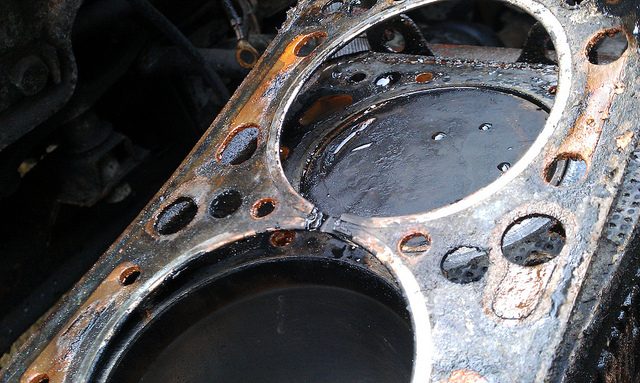Signs of a Blown Head Gasket
20th Jul 2016

The head gasket plays an important role in the function of automotive engines. This flat piece of meticulously cut metal creates an air-tight seal between the engine block and cylinder head. Assuming it functions as intended, it prevents cooling and combustion gasses from mixing together.
But it's not uncommon for head gaskets to fail. The single most common cause of a failed or "blown" head gasket is engine overheating. Going back to high school physics 101, heat causes things to expand. So when the engine overheats, it naturally expands. And when it cools, it shrinks or contracts back to its normal level. These fluctuations may cause an already weakened head gasket to crack, allowing combustion gases and coolant to mix together. So, how do you know if you've blown a head gasket in your car?
White Smoke from Exhaust
This is a tall-tale sign of a blown head gasket. When the head gasket fails, coolant may leak and escape through the exhaust, in which case it burns with a distinct white smoke. Vehicle exhaust gasses are normally transparent and invisible to the naked eye. But if you suddenly see your car shooting out white smoke from the tailpipe, you could have a blown head gasket.
Bubbles in Radiator
Another possible sign of a blown head gasket is bubbles in the radiator. When your engine is cool, remove the radiator cap and have someone turn on the ignition, giving it just enough gas so it's slightly over idle. Now closely watch the coolant sitting in the radiator. Some bubbles are to be expected, as cooling systems are under pressure. But if you see lots of bubbles coming out the radiator, it could mean you've blown a head gasket. This occurs when exhaust gases escape into the cooling system and out the radiator.
Milky Oil
With your engine turned off, pop the hood and pull the engine oil dipstick, paying close attention to its color. With a blown head gasket, the engine oil and coolant may mix together. You can identify this problem by looking for milky white oil.
Exhaust Gases in Coolant
You can buy a testing kit online that's designed to check for exhaust gases (e.g. CO2) in your car's coolant. It's a simple and highly effective way to determine if you have a blown head gasket that's affecting compression.
Of course, another solution is to have a pressure test performed. This test checks the pressure of each cylinder. If you have a blown head gasket or cracked block, pressure may escape from one or more cylinders a -- problem that's identified with a pressure test.
Photo credit: Tony Harrison

